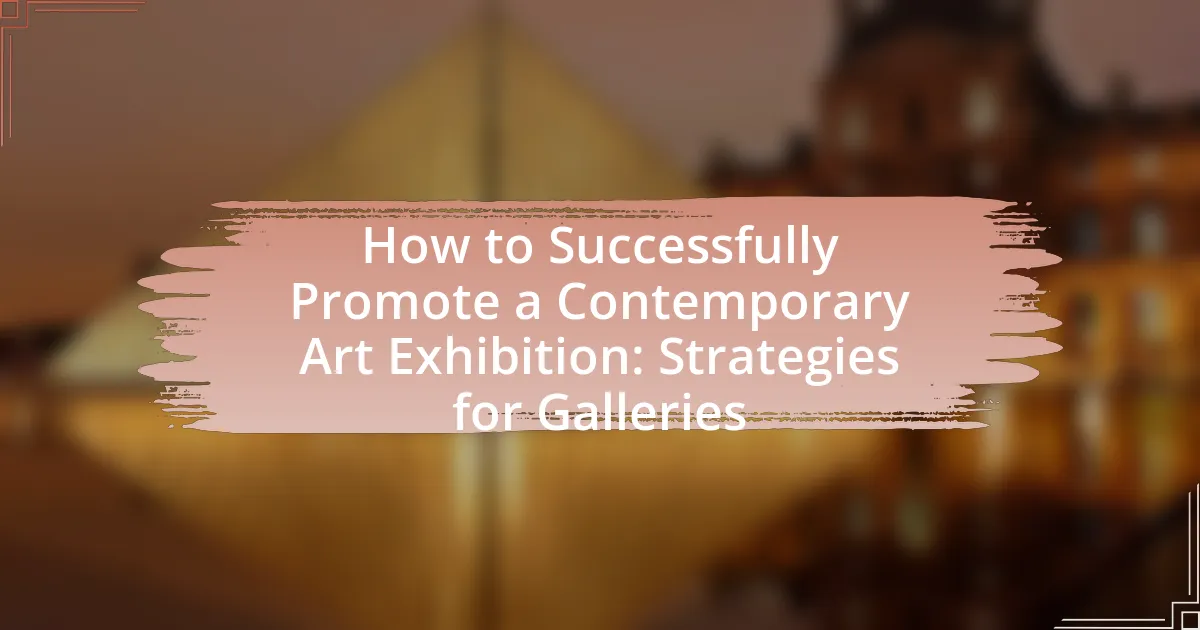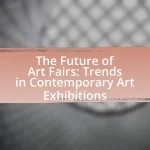The article focuses on effective strategies for promoting contemporary art exhibitions, emphasizing key elements such as targeted audience engagement, marketing strategies, and branding. It outlines how galleries can define their target audience through demographic analysis and tailor promotional efforts accordingly. The article also discusses the importance of utilizing various marketing channels, including social media and email marketing, while highlighting the role of community partnerships in enhancing visibility. Additionally, it addresses common challenges galleries face in exhibition promotion and offers solutions to overcome these obstacles, ensuring successful engagement and increased attendance.
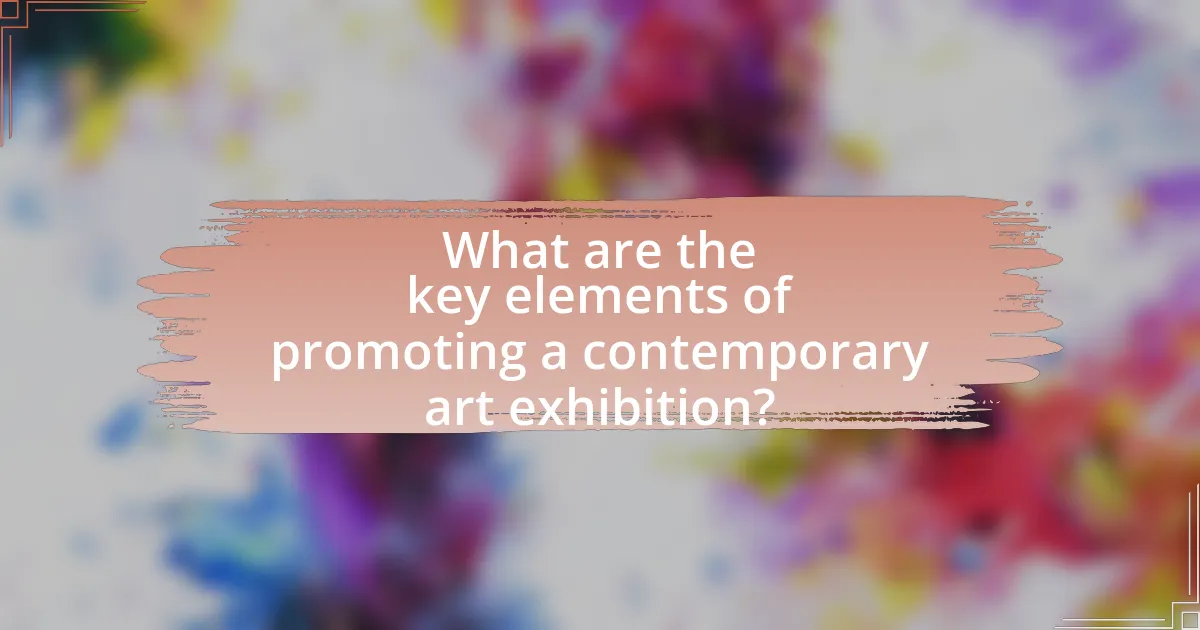
What are the key elements of promoting a contemporary art exhibition?
The key elements of promoting a contemporary art exhibition include effective marketing strategies, targeted audience engagement, and strategic partnerships. Effective marketing strategies involve utilizing social media platforms, email newsletters, and press releases to reach a broader audience. Targeted audience engagement focuses on identifying and connecting with specific demographics interested in contemporary art, which can be achieved through personalized invitations and community outreach. Strategic partnerships with local businesses, art institutions, and influencers can enhance visibility and credibility, as evidenced by successful exhibitions that have collaborated with well-known local galleries or artists, resulting in increased attendance and media coverage.
How do galleries define their target audience for exhibitions?
Galleries define their target audience for exhibitions by analyzing demographic data, art preferences, and engagement patterns of potential visitors. They often utilize surveys, social media analytics, and visitor feedback to identify characteristics such as age, income level, education, and cultural interests. For instance, a gallery may find that younger audiences are more engaged with contemporary art through platforms like Instagram, leading them to tailor exhibitions that resonate with this demographic. Additionally, galleries may study attendance records from past exhibitions to determine which types of art attract specific audience segments, thereby refining their marketing strategies to effectively reach and engage those groups.
What demographic factors should galleries consider when identifying their audience?
Galleries should consider age, income level, education, cultural background, and geographic location when identifying their audience. Age influences preferences for art styles and engagement methods; for instance, younger audiences may prefer digital art and social media promotion, while older audiences might favor traditional art forms. Income level affects purchasing power and willingness to invest in art, with higher-income individuals more likely to buy expensive pieces. Education impacts art appreciation and understanding, as more educated audiences may seek deeper engagement with the artwork. Cultural background shapes aesthetic preferences and interpretations, making it essential for galleries to tailor their offerings accordingly. Geographic location determines access to galleries and art events, influencing audience size and demographics. Understanding these factors allows galleries to effectively target their marketing strategies and enhance audience engagement.
How can galleries use audience insights to tailor their promotional strategies?
Galleries can use audience insights to tailor their promotional strategies by analyzing demographic data, preferences, and engagement patterns of their visitors. This analysis allows galleries to identify specific audience segments, enabling them to create targeted marketing campaigns that resonate with those groups. For instance, if data shows that a significant portion of visitors are young professionals interested in contemporary art, galleries can focus their promotional efforts on social media platforms popular among that demographic, such as Instagram. Additionally, insights into past exhibition attendance can inform galleries about which types of art or themes attract larger audiences, guiding future programming and promotional content. By leveraging these insights, galleries can enhance their outreach effectiveness, ultimately increasing attendance and engagement at exhibitions.
What role does branding play in the promotion of an exhibition?
Branding plays a crucial role in the promotion of an exhibition by establishing a distinct identity that resonates with the target audience. A strong brand creates recognition and trust, which are essential for attracting visitors. For instance, exhibitions that utilize cohesive branding strategies, including logos, color schemes, and messaging, can enhance visibility and engagement, leading to increased attendance. Research indicates that 77% of consumers make purchases based on brand recognition, highlighting the importance of branding in driving foot traffic to exhibitions.
How can galleries develop a strong brand identity for their exhibitions?
Galleries can develop a strong brand identity for their exhibitions by creating a cohesive visual and thematic narrative that resonates with their target audience. This involves designing consistent branding elements such as logos, color schemes, and typography that reflect the gallery’s mission and the specific exhibition’s theme. For instance, the Museum of Modern Art (MoMA) effectively utilizes a minimalist design approach that aligns with its contemporary art focus, enhancing its brand recognition. Additionally, galleries should engage in storytelling through marketing materials and social media, which helps to establish an emotional connection with visitors. Research indicates that 70% of consumers prefer brands that tell a story, highlighting the importance of narrative in brand identity. By consistently applying these strategies, galleries can create a memorable and distinct brand identity that attracts and retains audiences.
What are effective branding strategies for contemporary art exhibitions?
Effective branding strategies for contemporary art exhibitions include creating a strong visual identity, leveraging social media, and engaging with the community. A strong visual identity, characterized by a cohesive logo, color palette, and typography, helps establish recognition and memorability. Social media platforms, such as Instagram and Facebook, are essential for reaching a broader audience, showcasing artwork, and promoting events, as 70% of art buyers use social media to discover new artists and exhibitions. Engaging with the local community through partnerships, workshops, and events fosters relationships and encourages attendance, as community involvement can increase foot traffic by up to 30%. These strategies collectively enhance visibility and attract diverse audiences to contemporary art exhibitions.
Why is a marketing plan essential for exhibition promotion?
A marketing plan is essential for exhibition promotion because it provides a structured approach to reach target audiences effectively. By defining objectives, identifying key demographics, and outlining strategies, a marketing plan ensures that promotional efforts are focused and measurable. For instance, a well-crafted marketing plan can increase attendance by up to 30%, as evidenced by case studies from successful art exhibitions that utilized targeted social media campaigns and email marketing. This structured approach not only maximizes resource allocation but also enhances the overall impact of the exhibition, making it a critical component for success.
What components should be included in a marketing plan for an art exhibition?
A marketing plan for an art exhibition should include the following components: target audience analysis, branding strategy, promotional tactics, budget allocation, timeline, and evaluation metrics.
Target audience analysis identifies the demographics and psychographics of potential attendees, ensuring that marketing efforts are directed effectively. Branding strategy establishes a cohesive identity for the exhibition, including visual elements and messaging that resonate with the audience. Promotional tactics encompass various channels such as social media, email marketing, press releases, and partnerships with local businesses or influencers to maximize reach. Budget allocation outlines the financial resources dedicated to each marketing activity, ensuring cost-effectiveness. A timeline details the schedule for marketing activities leading up to the exhibition, allowing for organized execution. Finally, evaluation metrics define how the success of the marketing efforts will be measured, using tools like attendance numbers, engagement rates, and feedback surveys to assess effectiveness.
How can galleries measure the effectiveness of their marketing efforts?
Galleries can measure the effectiveness of their marketing efforts through various metrics such as attendance numbers, social media engagement, and sales data. By tracking attendance at exhibitions, galleries can assess how many visitors were attracted by specific marketing campaigns. Social media engagement metrics, including likes, shares, and comments, provide insights into audience interest and reach. Additionally, analyzing sales data before and after marketing initiatives can reveal the direct impact of those efforts on revenue. For instance, a gallery that sees a 30% increase in attendance following a targeted social media campaign can conclude that the marketing strategy was effective.
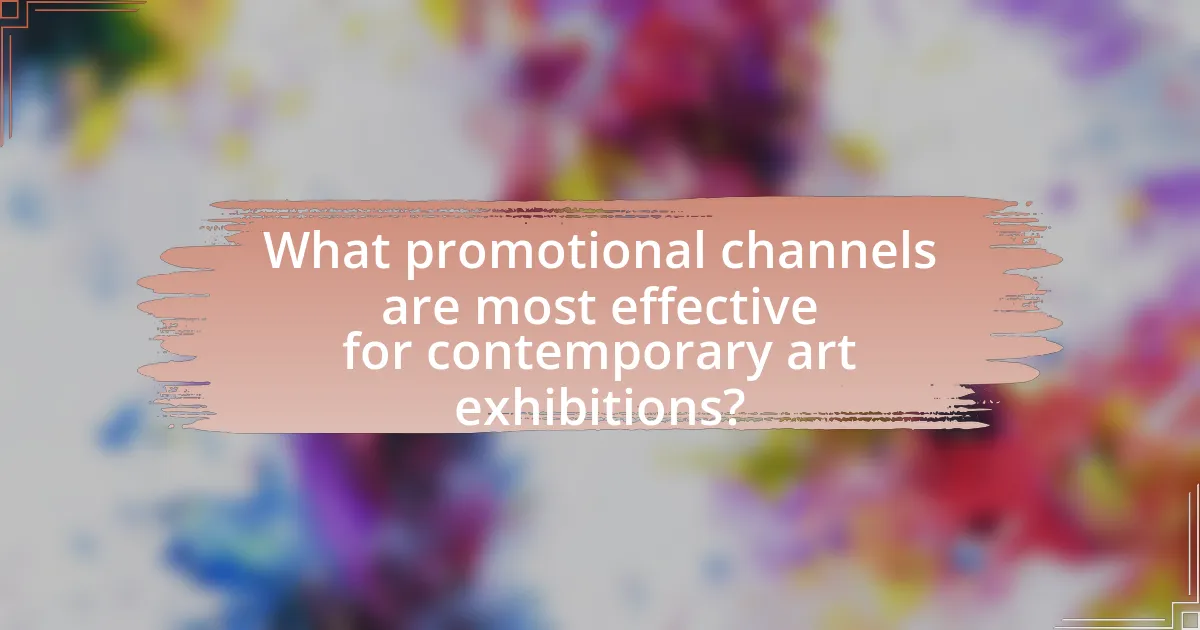
What promotional channels are most effective for contemporary art exhibitions?
Social media platforms, particularly Instagram and Facebook, are the most effective promotional channels for contemporary art exhibitions. These platforms allow galleries to reach a broad audience, engage with potential visitors through visual content, and create buzz around events. According to a survey by Art Basel and UBS, 70% of art collectors use social media to discover new artists and exhibitions, highlighting the importance of these channels in contemporary art promotion. Additionally, email marketing remains a strong tool, with a reported average open rate of 20% for art-related newsletters, effectively reaching dedicated audiences.
How can social media be leveraged for exhibition promotion?
Social media can be leveraged for exhibition promotion by creating targeted campaigns that engage potential attendees and showcase the exhibition’s highlights. Utilizing platforms like Instagram and Facebook allows galleries to share visually appealing content, such as artist interviews, behind-the-scenes footage, and sneak peeks of the artwork, which can generate excitement and anticipation. According to a study by the Pew Research Center, 69% of adults in the U.S. use social media, making it an effective channel to reach a broad audience. Additionally, using hashtags relevant to the exhibition can increase visibility and encourage user-generated content, further amplifying the promotional efforts.
What types of content should galleries share on social media platforms?
Galleries should share a variety of content types on social media platforms, including high-quality images of artworks, behind-the-scenes videos, artist interviews, exhibition previews, and event announcements. High-quality images of artworks attract attention and showcase the pieces effectively, while behind-the-scenes videos provide insight into the curation process and engage audiences. Artist interviews can humanize the artwork and create a connection with viewers, and exhibition previews generate excitement and anticipation. Event announcements keep followers informed about upcoming shows and activities, fostering community engagement. These content types are proven to enhance visibility and interaction, as galleries that utilize diverse content strategies often see increased audience engagement and attendance at exhibitions.
How can galleries engage their audience through social media interactions?
Galleries can engage their audience through social media interactions by creating interactive content that encourages participation, such as polls, Q&A sessions, and live streams of exhibitions. This approach fosters a sense of community and connection, as evidenced by a study from the Pew Research Center, which found that 69% of adults in the U.S. use social media, making it a vital platform for reaching and engaging audiences. Additionally, galleries can showcase behind-the-scenes content and artist interviews, which humanizes the art experience and invites followers to feel more involved. By responding to comments and messages promptly, galleries can further enhance engagement, as timely interactions have been shown to increase audience loyalty and interest in future events.
What traditional marketing methods still hold value in promoting art exhibitions?
Traditional marketing methods that still hold value in promoting art exhibitions include print advertising, direct mail campaigns, and networking events. Print advertising, such as flyers and posters, effectively reaches local audiences, as evidenced by a study showing that 70% of people remember the content of print ads. Direct mail campaigns allow galleries to target specific demographics, with a response rate of 4.4% compared to 0.12% for email marketing, according to the Data & Marketing Association. Networking events, including gallery openings and artist talks, foster community engagement and personal connections, which are crucial for building a loyal audience. These methods remain relevant due to their ability to create tangible connections and enhance visibility in local markets.
How can print media be effectively utilized in exhibition promotion?
Print media can be effectively utilized in exhibition promotion by creating visually appealing brochures, flyers, and posters that convey essential information about the event. These materials can be strategically distributed in high-traffic areas, such as art supply stores, cafes, and cultural centers, to reach the target audience. Research indicates that 79% of people can recall the brand on a printed piece they received in the last month, highlighting the effectiveness of print media in enhancing brand recognition. Additionally, including QR codes on print materials can direct potential attendees to online resources, such as event websites or social media pages, further engaging them and providing more information.
What role do partnerships with local businesses play in traditional marketing strategies?
Partnerships with local businesses enhance traditional marketing strategies by increasing visibility and credibility within the community. Collaborating with local businesses allows galleries to tap into established customer bases, thereby expanding their reach. For instance, co-hosting events or cross-promoting exhibitions can attract diverse audiences, as seen in successful collaborations between art galleries and local cafes or shops that draw in their regular patrons. This synergy not only fosters community engagement but also reinforces brand loyalty, as consumers often prefer supporting businesses that contribute to their local economy.
How can galleries utilize email marketing to reach potential visitors?
Galleries can utilize email marketing to reach potential visitors by creating targeted email campaigns that highlight upcoming exhibitions, events, and special promotions. By segmenting their email lists based on visitor interests and past attendance, galleries can tailor content to specific audiences, increasing engagement rates. According to a study by Campaign Monitor, personalized emails can generate six times higher transaction rates compared to non-personalized messages. Additionally, galleries can include visually appealing images of artworks and artist interviews in their emails to capture interest and encourage attendance.
What are best practices for crafting effective exhibition announcement emails?
Best practices for crafting effective exhibition announcement emails include creating a compelling subject line, providing essential details about the exhibition, and incorporating visually appealing elements. A compelling subject line captures attention and encourages recipients to open the email; studies show that 47% of email recipients decide whether to open an email based solely on the subject line. Essential details such as the exhibition title, dates, location, and featured artists should be clearly presented to ensure recipients have all necessary information at a glance. Additionally, using high-quality images of the artwork can enhance engagement, as emails with images can increase click-through rates by 42%. Finally, including a clear call to action, such as RSVP links or social media sharing options, encourages recipients to take the next step, further promoting the exhibition.
How can galleries segment their email lists for targeted promotions?
Galleries can segment their email lists for targeted promotions by categorizing subscribers based on specific criteria such as past purchase behavior, engagement levels, geographic location, and expressed interests. For instance, galleries can analyze previous attendance records to identify frequent visitors and tailor promotions for upcoming exhibitions that align with their preferences. Additionally, geographic segmentation allows galleries to send localized promotions to subscribers in proximity to the gallery, enhancing the likelihood of attendance. Research indicates that targeted email campaigns can yield a 760% increase in revenue, demonstrating the effectiveness of segmentation in driving engagement and sales.
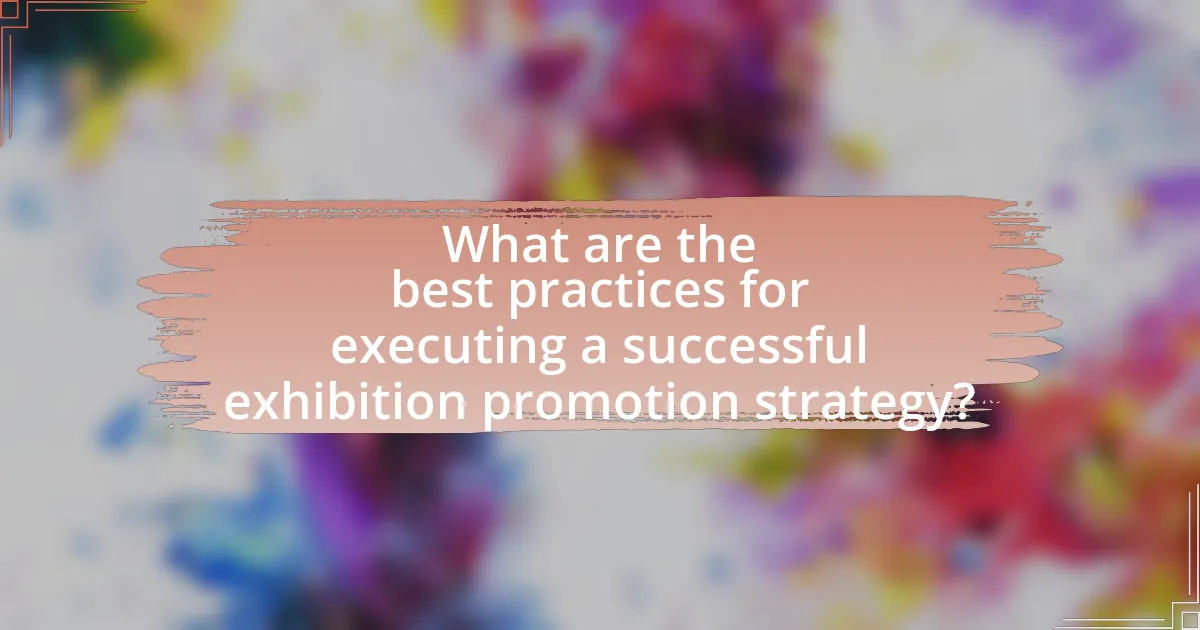
What are the best practices for executing a successful exhibition promotion strategy?
The best practices for executing a successful exhibition promotion strategy include identifying the target audience, utilizing multiple marketing channels, and engaging with the community. Identifying the target audience allows galleries to tailor their messaging and outreach efforts effectively, ensuring that promotional materials resonate with potential visitors. Utilizing multiple marketing channels, such as social media, email newsletters, and local press, maximizes reach and visibility, as studies show that campaigns using diverse platforms can increase engagement by up to 50%. Engaging with the community through partnerships, events, and collaborations fosters a sense of connection and encourages attendance, as community-driven initiatives have been shown to enhance visitor turnout significantly.
How can galleries create engaging promotional materials?
Galleries can create engaging promotional materials by utilizing visually striking designs, clear messaging, and targeted distribution strategies. Effective promotional materials should feature high-quality images of artwork, concise descriptions, and compelling narratives that resonate with the audience. Research indicates that visuals can increase engagement by up to 94%, highlighting the importance of aesthetic appeal in promotional content. Additionally, galleries should leverage social media platforms and email marketing to reach specific demographics, ensuring that the materials are distributed to potential attendees who are most likely to be interested in the exhibition.
What design elements are crucial for effective exhibition flyers and posters?
Effective exhibition flyers and posters require a combination of visual hierarchy, clear typography, compelling imagery, and concise messaging. Visual hierarchy ensures that the most important information, such as the exhibition title and date, stands out, guiding the viewer’s attention. Clear typography enhances readability, with font choices that reflect the exhibition’s theme while remaining legible from a distance. Compelling imagery, often featuring artwork from the exhibition, captures interest and conveys the artistic essence. Concise messaging communicates essential details without overwhelming the viewer, typically including the exhibition’s purpose, location, and contact information. These elements collectively enhance the flyer or poster’s effectiveness in attracting an audience to the exhibition.
How can galleries ensure their promotional materials convey the exhibition’s theme?
Galleries can ensure their promotional materials convey the exhibition’s theme by aligning visual elements, language, and design with the core message of the exhibition. This alignment can be achieved through the use of specific imagery that reflects the theme, carefully chosen typography that resonates with the exhibition’s tone, and concise text that encapsulates the main ideas. For instance, if an exhibition focuses on environmental issues, using earthy colors and images of nature can reinforce the theme. Research indicates that cohesive branding in promotional materials increases audience engagement by up to 70%, demonstrating the effectiveness of a unified approach in conveying thematic content.
What strategies can galleries implement for event day promotion?
Galleries can implement several effective strategies for event day promotion, including leveraging social media, engaging local influencers, and utilizing email marketing. Social media platforms like Instagram and Facebook allow galleries to create event pages, share engaging content, and interact with potential attendees, which can significantly increase visibility and attendance. Engaging local influencers can amplify reach, as their followers may be interested in the event, thus driving more foot traffic. Email marketing serves as a direct communication channel to remind subscribers about the event, providing essential details and encouraging attendance. According to a study by the Content Marketing Institute, 93% of marketers use social media for business, highlighting its effectiveness in event promotion.
How can galleries enhance visitor experience during the exhibition opening?
Galleries can enhance visitor experience during the exhibition opening by providing interactive elements, engaging programming, and personalized services. Interactive elements, such as guided tours or artist talks, allow visitors to connect more deeply with the artwork and its context. Engaging programming, including live performances or workshops, creates a dynamic atmosphere that encourages participation and fosters community. Personalized services, such as tailored recommendations based on visitor interests, enhance the overall experience by making it more relevant and memorable. These strategies have been shown to increase visitor satisfaction and retention, as evidenced by studies indicating that interactive and engaging experiences lead to higher levels of visitor engagement and enjoyment in cultural settings.
What follow-up strategies should galleries use post-exhibition to maintain engagement?
Galleries should implement targeted email campaigns to maintain engagement post-exhibition. These campaigns can include personalized thank-you messages to attendees, updates on upcoming exhibitions, and exclusive content related to the artists featured. Research indicates that personalized communication increases engagement rates by up to 29%, demonstrating the effectiveness of tailored outreach. Additionally, galleries can utilize social media platforms to share highlights from the exhibition, artist interviews, and behind-the-scenes content, fostering a sense of community and ongoing interest. Engaging with visitors through surveys to gather feedback can also enhance future exhibitions and strengthen relationships, as 70% of consumers prefer brands that listen and respond to their feedback.
What common challenges do galleries face in promoting exhibitions, and how can they overcome them?
Galleries commonly face challenges such as limited budgets, competition for audience attention, and difficulties in reaching target demographics when promoting exhibitions. To overcome limited budgets, galleries can leverage social media platforms and community partnerships to enhance visibility without significant financial investment. Addressing competition involves creating unique narratives around exhibitions that resonate with potential visitors, thereby differentiating their offerings. Additionally, utilizing data analytics can help galleries identify and engage specific demographics more effectively, ensuring that promotional efforts are targeted and efficient.
What are the most frequent pitfalls in exhibition promotion, and how can they be avoided?
The most frequent pitfalls in exhibition promotion include inadequate audience targeting, poor timing, and insufficient marketing channels. To avoid these pitfalls, galleries should conduct thorough market research to identify their target audience, schedule promotions well in advance of the exhibition date, and utilize a diverse range of marketing channels such as social media, email newsletters, and local partnerships. For instance, a study by the National Endowment for the Arts found that targeted marketing significantly increases attendance rates, demonstrating the importance of understanding the audience. Additionally, timing promotions to coincide with local events can enhance visibility and engagement, as evidenced by successful exhibitions that strategically align their opening dates with community activities.
How can galleries adapt their strategies based on feedback and results?
Galleries can adapt their strategies based on feedback and results by systematically analyzing visitor responses and engagement metrics. For instance, if feedback indicates that certain types of exhibitions attract more visitors, galleries can prioritize similar themes or artists in future shows. Additionally, tracking attendance data and social media interactions can reveal which marketing tactics are most effective, allowing galleries to refine their promotional efforts accordingly. Research shows that galleries that actively incorporate visitor feedback into their planning see a 20% increase in repeat attendance, demonstrating the tangible benefits of responsive strategy adjustments.
